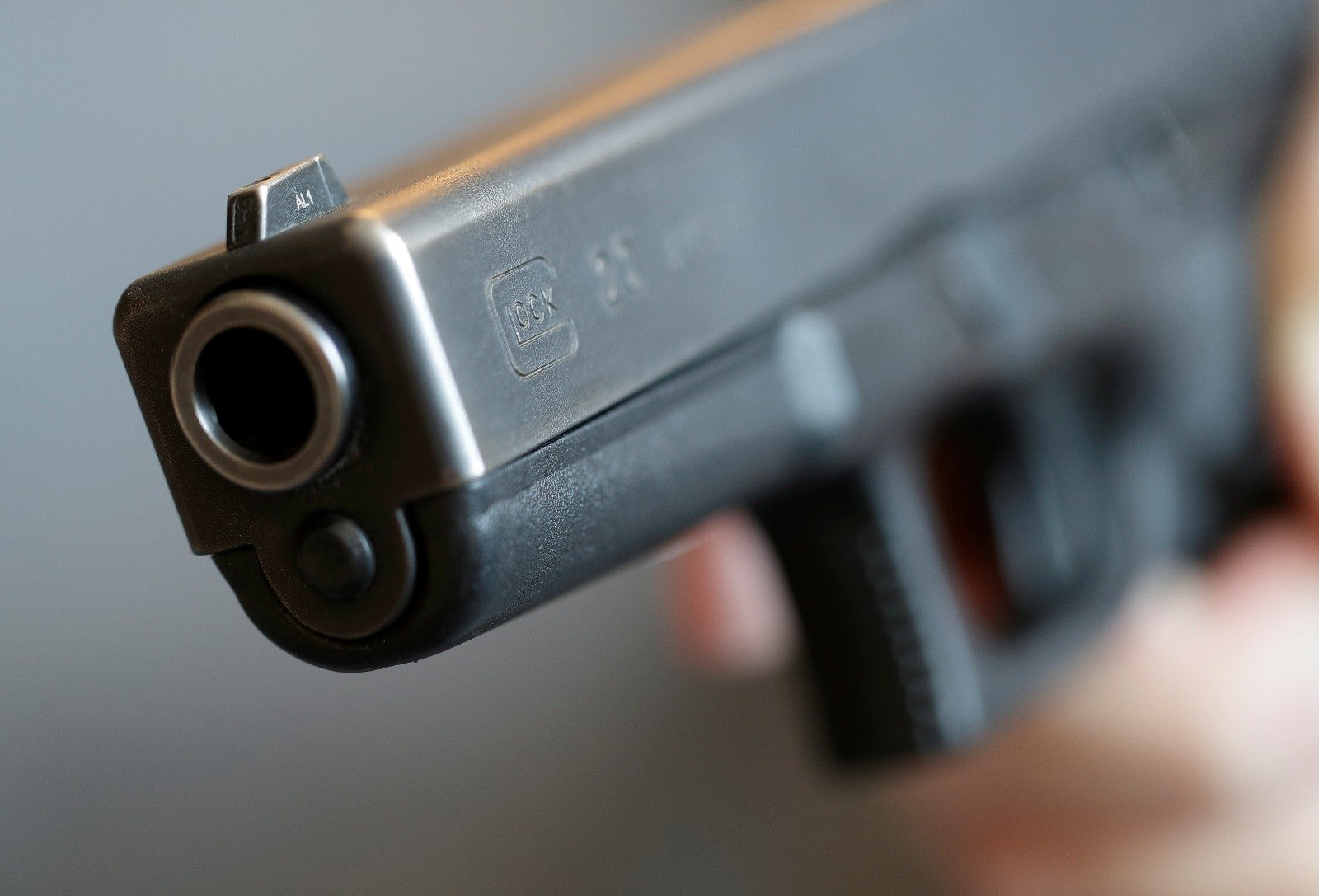Glock 17 Vs 21 - The Glock 21 bridges the gap between old and new, combining a powerful old favorite cartridge with modern handgun technology. Not only has the pistol been successful in the civilian market, but it has helped a whole new generation of gun owners acquire their own .45 ACP pistols. While some enthusiasts may never take to the lightweight polymer frame, there is no doubt that the pistol has helped keep interest in the .45 ACP cartridge alive, breathing new life into the old cartridge.
In 1990, the world of the .45 ACP cartridge was turned upside down. For more than seventy years, the Colt Field 1911, a new Austrian revolver, has dared to use the venerable old bullet in a modern design that primarily includes a polymer frame. Glock's adoption of the .45 ACP in the new Glock 21 arguably saved the cartridge—and all of its users—from obscurity and made the big-bore cartridge a must-have for a new generation of handguns.
Glock 17 Vs 21

Invented in 1911 by firearms inventor John Moses Browning, the Colt 1911 pistol uses the .45 ACP cartridge—also invented by Browning. Together, the pistol and cartridge were designed to address the U.S. military's lack of handgun stopping power, first noticed during the Philippine Insurrection, when existing Army .38 Long Colt revolvers proved incapable of stopping the Moro rebels in their tracks. Adopted by the US Army as the M1911 and later the M1911A1, the Browning pistol served until the early 1980s.
Glock 21 Gen 4
The .45 ACP cartridge has proven to be significantly more effective than the .38 Long Colt the Army used during the insurgency, with more than twice the energy per foot at the muzzle. The .45 ACP/1911 combination has grown in popularity over the years, and although it was dropped by the military in the 1980s, the 1911 platform still has a loyal following thirty years later.
The advent of Ninem pistols, largely fueled by the Glock 17, has put a question mark over the .45 ACP. After police agencies, gendarmerie, and militaries switched to the 9mm cartridge, it seemed to lack an anchor in government service. American gun users, who previously had to choose between .45 ACP, .357 Magnum and .38 Special, have all flocked to their new high-capacity magazine revolver. The .45 ACP can move into its niche. Then in 1990, Glock introduced the Glock 21: .45 ACP Glock.
After issuing the original Glock 17, Glock apparently decided that the design was mature enough to handle the larger calibers. In 1990, the company released the Glock 20 (ten millimeter), Glock 21 (.45 ACP), and Glock 22 (.40 Smith & Wesson). The Glock 21 was issued with a focus on the military and law enforcement, gun enthusiasts, home defense, and even hunting.
Selling a Glock 21 to existing Glock owners was a relatively easy task. The Glock 21 was just an expansion of the Glock 17. On the other hand, reaching existing .45 ACP owners was a more difficult task. 1911 owners are likely to love their handgun for the historical significance, tradition, and reliability of the 1911. Owning a .45, even with a more modern design, is owning a piece of history and a weapon backed by decades of service.
Glock 17 Vs 19. Which Is Better? [2022]
The Glock 21 is 8.22 inches in length, only one-fifth of an inch longer than the Glock 17. The two pistols are nearly identical in height, at 5.47 and 5.43 inches respectively, and at 1.27 inches, the Glock 21 is only a hair wider than it is to hold. the wider circle. The 29.84-ounce Glock 21 is slightly heavier than the 25.06-ounce Glock 17 unloaded. Trigger pull is the same 5.5 pounds for the same pistols, and trigger travel is the same .49 inches.
It is the carrying capacity that makes the Glock 21 stand out over other designs. The Glock 21 holds ten rounds of .45 ACP in an internal magazine, yet weighs only 38.48 ounces. By contrast, the 1911 weighs 42 ounces with a flat, seven-round internal magazine. (Ten-round magazines exist for the 1911, but they stand out prominently outside the magwell.) Glock’s early adoption of high-capacity double-stack magazines helped alleviate the .45 ACP’s circumference problem. Although the Glock 21 does not have the famously thin grips of the 1911A1, the grip width is uncomfortable for those with smaller hands.
Although the polymer and steel Glock 21 weighs less than the all-steel 1911A1, recoil for both rifles is remarkably similar. Perhaps this is a function of the cartridge itself. The recoil isn't unpleasant, being less of a kick and more of a forceful push or push back.

In 2007, Glock released a new version of the Glock 21, the Glock 21 SF. Designed to compete for the DoD contract, the Glock 21 SF (Short Frame) had a smaller stock to accommodate smaller hands more easily and a two-handed magazine release. However, the Glock 21 failed to make its way into the US military and law enforcement, possibly due to concerns about recoil and the smaller magazine size.
Lone Wolf 1911 Style Glock 17/22 (g17/22) Pistol Frame (polymer Grip Frame) With Extended Beavertail Tang: Glock Meets 1911 Pistol For The Best Of All Worlds? (pics!)
While proponents of the .45 ACP—and proponents of the .45 ACP/1911 in particular—may have strong reservations about polymer pistols in general and the Glock 21 in particular, the pistol has won many supporters. The Glock 21 is a very reliable pistol and an absolute must for most gun enthusiasts. The success of the Glock 21 has meant that other manufacturers, including Smith & Wesson, Sig Sauer, Heckler & Koch, and Springfield Armory, have all introduced .45 versions of their higher-capacity 9mm pistols. All of this has increased the visibility and popularity of the .45 ACP cartridge and may take fans of newer handguns back to the 1911. Of all the .45 semi-automatic handgun options, the Glock certainly holds a respectable place. Glock is known for its reliable and simple designs—important factors for many shooters. Glock was able to mediate between those who wanted larger caliber ammunition in a handgun and those who were tired of carrying only 6 or 7 rounds in the magazine. This brings us to the firearm we're looking at in this review, the Glock 21.
Glock introduced the G21 SF (Short Frame) in 2007 to compete for the Department of Defense contract. The decade did not end in decline, but the firearm has gained traction with law enforcement and civilians because of its unique features. Based on the Generation 3 Glock 21, the company has made only a few modifications to this variant. We fired and operated a Glock 21 SF for this Glock 21 review.
Of the modifications seen on the Glock 21 SF, the most notable (as the name suggests) is the smaller frame circumference. Not to be confused with frame width, the short frame offers a smaller frame depth than the Gen 3 version of the Glock 21. This shorter frame depth allows those with smaller hands the ability to get adequate grip and reach features. On newer generations (Gen 4), the Glock 21's grip length was nearly identical to that of the G21 SF.
As mentioned earlier, the Glock 21 SF is chambered in one of the “big boy” calibers – .45 ACP. Most shooters know the 45 ACP as a classic caliber, and many self-defense shooters still rely on the cartridge today.
Finally Found My White(gray) Whale
Glock combines tradition and capability in the Glock 21 SF. A capacity of 13 + 1 is offered in the Glock 21 SF — a seemingly reasonable number given the frame size.
Another unique aspect of the Glock 21 SF is the inclusion of an ambidextrous magazine release. While this feature is handy, I felt like the functionality was missing. I'll go into this in more detail later in the review. A few Glock 21 SFs have been made with a Picatinny rail for mounting accessories—still too few and holster compatibility is an issue.
Many of the Glock 21 SF variants available today are from police departments that have retired from service use. These alternatives can be found for as little as $350-400 in some places - a lot to be sure.

When I first got my hands on the G21, I quickly felt right at home with it in my hand. I know not everyone likes or even enjoys “trying” a Glock, but as someone who owns and uses Glocks, it felt comfortable. Some would argue that the Glock is an “acquired” taste—whether you like the Glock’s ergonomics or not, the 21 SF will feel good.
Glock 17 Gen 5 Vs. Gen 2
Even though it's designed for use by people with different hand sizes, the frame still has a sturdy feel to it. I shoot a Glock 17 quite often and this frame provides more grip than the 17. While I don't mind the feel or size of the frame, I did have some issues getting to the magazine release. I'll get to that later when I talk about the functional side of things.
My expectations of how this gun would handle recoil and run in general were wrong. Depending on the caliber, I would have expected a little more difficulty with these follow-up shots.
Hibiki 17 vs 21, glock 30 vs 21, glock 41 vs 21, glock 17 holster, glock 17 iwb holster, glock 17 serpa holster, safariland glock 17, glock 17 holster reviews, glock gen 4 17, glock 17 case, glock 17 holsters, cleaning a glock 17
0 Comments